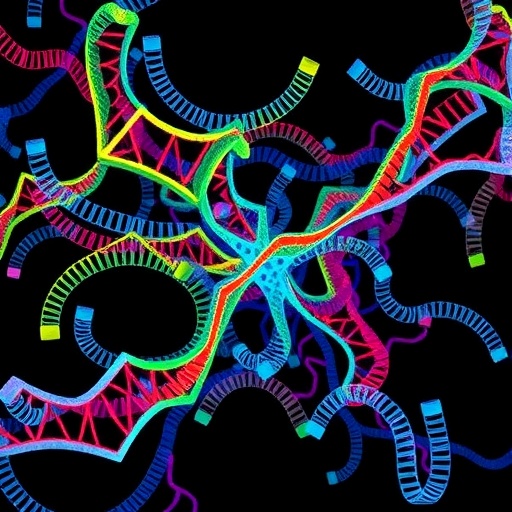Recent advancements in single-cell RNA sequencing (scRNA-seq) have provided unprecedented insights into cellular heterogeneity and gene expression in various biological contexts. However, the complexity of scRNA-seq data poses significant challenges for accurate clustering and interpretation. In their groundbreaking research, Tang et al. introduce a state-of-the-art model that combines the strengths of adversarial autoencoders with graph networks to enhance clustering robustness. This innovative approach, outlined in their article published in BMC Genomics, addresses the critical demand for reliable tools to analyze single-cell data.
The authors identify that traditional clustering methods often fail to account for the intricate relationships present within high-dimensional scRNA-seq datasets. Conventional algorithms, while useful, tend to overlook the underlying topology of the data, leading to unreliable clustering outcomes. Addressing this gap, the hybrid model proposed by Tang et al. integrates dynamic fusion techniques to strengthen the clustering process by effectively managing the noise and variability endemic to single-cell data.
At the heart of their model lies the adversarial autoencoder, which is strategically designed to learn compact, informative representations of the scRNA-seq data. This component plays a pivotal role in mitigating the noise inherent in single-cell datasets, allowing the subsequent clustering phase to operate on data that is both simplified and enriched. By capturing the distribution of the data more accurately, the adversarial autoencoder sets the groundwork for deeper insights into cellular populations.
The innovative use of graph networks is another critical element of Tang et al.’s methodology. These networks are adept at modeling the intricate connections between cells, allowing for a more nuanced understanding of cellular relationships. By constructing a graph that reflects the similarity between cells based on their gene expression profiles, the model enhances the ability to identify clusters that represent biologically relevant groupings. This graph-based approach not only improves the clustering accuracy but also facilitates the exploration of cellular interactions that could hold significant biological implications.
Dynamic fusion is an additional cornerstone of this model’s effectiveness. By continuously integrating features from both the adversarial autoencoder and the graph network, the framework maintains flexibility in the face of varying data distributions. This dynamic aspect is crucial when working with scRNA-seq data, as it allows the model to adapt to the unique characteristics of different datasets rather than relying on a static approach. The ability to respond dynamically enhances the model’s robustness and its potential for widespread applications in genomics.
Furthermore, Tang et al. validate their model using several benchmark datasets, demonstrating its superior performance relative to existing clustering methods. The results speak volumes about the promise of this hybrid approach, revealing not only improvements in cluster identification but also enhanced stability across different types of scRNA-seq data. Such robustness is particularly important in biological research, where variability can arise from numerous sources, including technical noise and biological differences among samples.
To quantify the improvements facilitated by their model, the authors employ a series of metrics that evaluate clustering performance against established benchmarks. Their findings demonstrate that the hybrid adversarial autoencoder-graph network consistently yields enhanced clustering outcomes, even in challenging scenarios characterized by high noise levels and low sample sizes. This level of reliability positions the model as a powerful tool for researchers navigating the complexities of single-cell genomics.
As scRNA-seq technology continues to evolve, so too does the need for sophisticated analytical techniques capable of keeping pace with these developments. The model proposed by Tang et al. not only meets this need but also opens new avenues for exploratory research. By facilitating more accurate clustering, researchers are empowered to uncover previously hidden cellular subpopulations that may play critical roles in health and disease.
Moreover, the implications of enhanced clustering extend beyond fundamental biology into translational research. With more reliable clusters, researchers can better understand disease mechanisms, identify potential therapeutic targets, and develop personalized medicine strategies. The ability to dissect cellular complexity is not just an academic pursuit; it has real-world implications for improving patient outcomes.
In conclusion, the research conducted by Tang and colleagues represents a significant step forward in the analysis of scRNA-seq data. By combining adversarial autoencoders with graph networks and incorporating dynamic fusion, they have crafted a model that is both robust and adaptable to various data scenarios. Their work not only addresses a pressing need in the field of genomics but also paves the way for future innovations in single-cell analysis. Researchers and clinicians alike will benefit from the insights gained through this advanced clustering approach, leading to a deeper understanding of cellular biology and its applications in health.
The promise of this hybrid model lies in its capacity to be refined further, possibly integrating additional machine learning techniques or expanding its applicability to other forms of omics data. As the realm of computational biology continues to grow, the innovative strides made by Tang et al. are poised to influence the direction of future research significantly, making them a group to watch closely in the coming years.
In summary, the adoption of Tang et al.’s method can revolutionize how researchers approach the analysis of high-dimensional biological data. With its focus on robustness, adaptability, and accuracy, this hybrid model represents a leap forward in the landscape of scRNA-seq clustering, offering the scientific community a powerful tool for unlocking the mysteries of cellular behavior.
Subject of Research: Hybrid adversarial autoencoder-graph network model for scRNA-seq clustering
Article Title: A hybrid adversarial autoencoder-graph network model with dynamic fusion for robust scRNA-seq clustering
Article References:
Tang, B., Feng, Y. & Gao, X. A hybrid adversarial autoencoder-graph network model with dynamic fusion for robust scRNA-seq clustering.
BMC Genomics 26, 749 (2025). https://doi.org/10.1186/s12864-025-11941-y
Image Credits: AI Generated
DOI: 10.1186/s12864-025-11941-y
Keywords: scRNA-seq, clustering, adversarial autoencoder, graph network, dynamic fusion, machine learning, genomics.
Tags: addressing noise in scRNA-seq datasetsadversarial autoencoders in genomicsBMC Genomics research articlesclustering challenges in bioinformaticsdynamic fusion model in data analysisgraph networks for RNA sequencinghigh-dimensional gene expression datainnovative approaches to cellular heterogeneityintegrating machine learning with genomicsrobust clustering methods for single-cell datascRNA-seq clustering techniquessingle-cell RNA sequencing advancements





